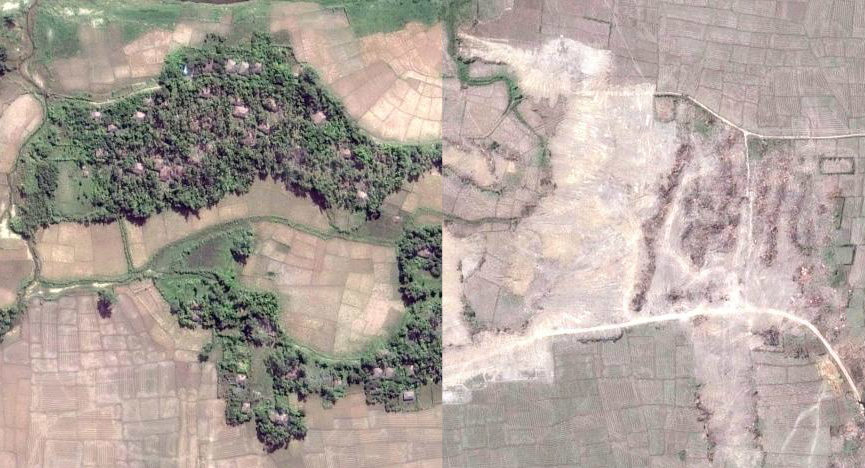Newly analyzed satellite imagery has revealed that the Myanmar government has bulldozed at least 55 Rohingya villages that were depopulated by a military ethnic cleansing campaign that began last August. Human Rights Watch (HRW) says these villages are “crime scenes” and is calling on the UN to demand an end to their demolition until they can be investigated by a UN-appointed fact-finding mission.
“Many of these villages were scenes of atrocities against Rohingya and should be preserved so that the experts appointed by the UN to document these abuses can properly evaluate the evidence to identify those responsible,” said HRW’s Asia director Brad Adams was quoted as saying in a report released by the organization today. “Bulldozing these areas threatens to erase both the memory and the legal claims of the Rohingya who lived there.”
Most of the 55 demolished villages are among the 362 that were destroyed by Myanmar security forces and Rakhine Buddhist vigilante groups in the wake of attacks on security outposts by the Rohingya insurgent group ARSA on Aug. 25, 2017. However, two of the villages were completely intact and likely habitable before Myanmar authorities took to them with heavy machinery.
The satellite images of the villages before and after demolition were captured between Nov. 11, 2017, and Feb. 19, 2018. They suggest that the demolitions are ongoing.
HRW said it could not independently verify if any of the destroyed villages were inhabited when the demolition began.
The demolitions are being carried out by the Union Enterprise for Humanitarian Assistance, Resettlement and Development (UEHRD), which was established in Oct. 2017 and is chaired by State Counsellor Aung San Suu Kyi. Government officials involved in the project have said the bulldozing is part of a plan to rebuild them to a higher standard for repatriated refugees.
However, the facilities that have been built on some of the cleared land have been described by observers as “prison camps.” Other projects on cleared Rohingya land have focused on road improvements.
Under international law, the more than 680,000 Rohingya refugees now in Bangladesh must be guaranteed the return of their property and the right to return to their place of residence or to the place of their choice. As such, HRW says the demolition of their villages constitutes obstruction of justice.
“The government’s clearing of dozens of villages only heightens concerns about Rohingya families being able to return home,” Adams said.
“Deliberately demolishing villages to destroy evidence of grave crimes is obstruction of justice. Donor governments should ensure they don’t provide any direct or indirect support that would hamper justice or assist those responsible for ethnic cleansing in their efforts to pretend the Rohingya do not have the right to return to their villages in northern Rakhine State.”



Reader Interactions